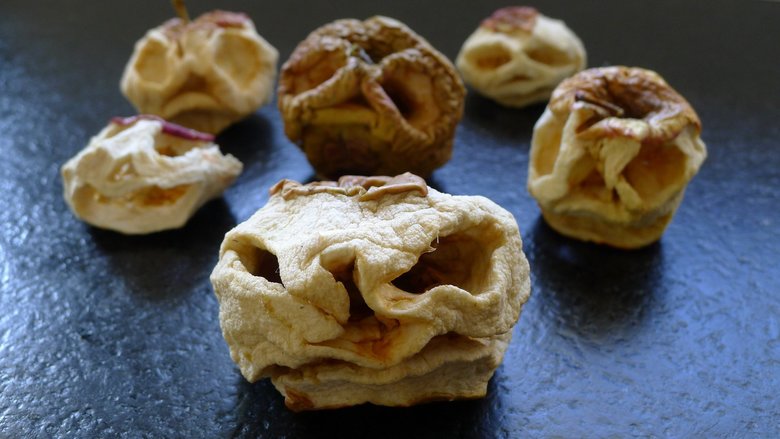Download: word.doc here | Image file here | Return to Editor’s Lounge

For the candy industry, Halloween is like Christmas. The five biggest candy shopping days of the year are all in October, as All Hallows’ Eve sells more candy than any other holiday.
Before being co-opted by big sugar in the 1950s, the roots of Halloween extend back to a Celtic tradition called Samhain, which honors that moment each year when fall blows in. Samhain’s founding observers saw it as a time when the boundaries between the living and spirit worlds became porous, allowing the spirits to come bang on your door like neighborhood trick or treaters.
As time passed and history was written, Samhain absorbed other holidays that also reflected the characteristics of the season, including harvest, death, wind, and the abundance of sweet fruits dangling from trees. Appropriately enough, after the Celts were conquered by the Romans, Samhain was combined with Pomona, a celebration of the Roman goddess of the harvest, according to History.com.
Today, while nature’s candy dangles from trees like a real-life fairy tail, we spend more than $9 billion each year on plastic sacks filled with little shiny bits of chocolate-stuffed packaging.
Apples are the second-most popular fruit in America, after bananas. But fruit, alas, is not as popular as candy. The same way Samhain opens the door to the world of the dead, candy opens the floodgates for evil sugar spirits to enter the bodies of children.
The sweetness of an apple, by contrast, doesn’t turn kids into little poltergeists, and the fruit has long been used as a barometer of hunger. Growing up, many people of certain generations were told, “If you aren’t hungry enough to eat an apple, you aren’t really hungry.” The same has never been said about candy.
I’m not suggesting people give out apples for Halloween. That would be irresponsible. By convention, and for everyone’s peace of mind and legal protection, all sugar toxins distributed to trick or treaters must be hermetically sealed for safety.
I have an apple tree that produces McIntosh-like apples, blushing dark red with a piercing flavor that’s like an arms race between sweet and tart. Most of the apples go through the cider press, but I’ve saved a few boxes of the biggest, most beautiful individuals to eat the old fashioned way. I’ve been thinking a lot about the apple hunger test, and noticing that when I’m hungry enough to eat an apple, the fruit’s characteristics become extra vivid. The perfume, sharpness and sweetness all become more enticing.
With cider, any fruit without a worm is a bonus. But if you don’t have access to a cider press, another option for apples — blemished or otherwise — is to carve them into apple Jack-o’-Lanterns.
Essentially, treat an apple like a mini-pumpkin, and then let it dry and shrivel into something that resembles a shrunken head. Apple is softer and more forgiving than pumpkin, and you can snack on the bits that you carve away.
If you live in a sunny climate, you can shrink apple heads on a windowsill in about a week. You can also use an oven on the lowest setting, or proximity to a heater. But these won’t be edible like a dehydrated apple jack-o’-lantern.
My family carved a bunch of apples one night. The next day, when my son was at school, I took a nibble off the corner of one of his, and my eyes got as big as his ghoul’s. We had rubbed them with lime juice to keep the apple jack-o-lanterns from browning, and that, it turns out, adds extra zing that is shockingly delicious. I like them apples better than candy. But good luck convincing the trick-or-treaters.
Apple Jack-o’-Lanterns
A dehydrator with shelving you can space widely enough to accommodate an entire apple is the device of choice with which to make these sweet and sassy skulls. If this project becomes the impetus to buy a dehydrator, you won’t be sorry. Also extremely helpful: a tomato corer, or similar cutting spoon.
Serves an army of spooky undead shrunken-headed zombies
Apples, the bigger the better
Lime or lemon juice
Peel the apple, going around its “equator,” while leaving a bit of peel around the stem end and its opposite “pole.” When peeled, look at the apple and decide where the face should be. Then use the coring spoon to scoop out the core from the opposite side, leaving a big hole in the back of the shrunken head. Scooping the insides allows the apple jack-o’-lanterns to dry more quickly.
Next, carve the mouth, otherwise you might not have enough room below the eyes and nose. That is the extent of any artistic advice that I should be giving, other than to make sure the nose is smaller than the eyes.
Rub the carved apple with lemon or lime juice and place in the center of a dehydrator, with the temperature at 135, for about 12 hours. If using an oven, set it on the lowest setting, with convection on if you’ve got it, and keep a watchful eye on them apples for about 2-6 hours, depending on the situation.
Whatever equipment you employ, you should test your process all the way through with just an apple or two before carving your personal army of sweet ghouls. You are not only testing your gear, but your technique and process. Learn how it dries, with or without pieces of peel. If a big scary mouth clenches into a grimace, pry it open into more of a primordial scream. Little touches like that can make all the difference on Halloween.